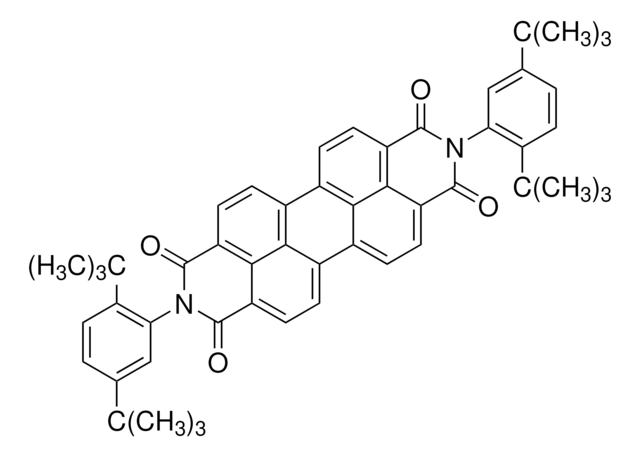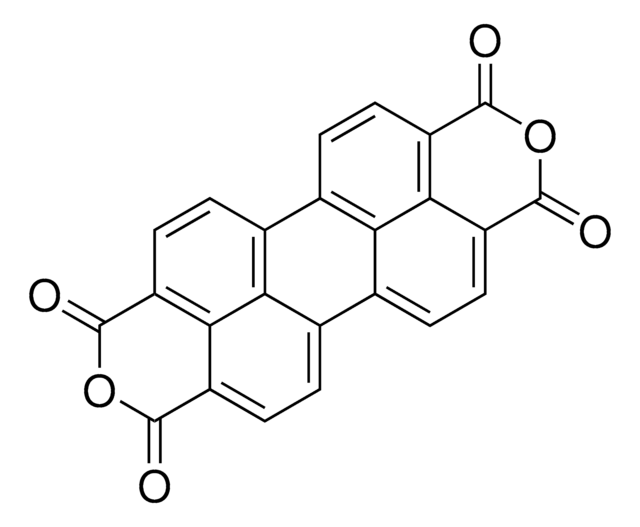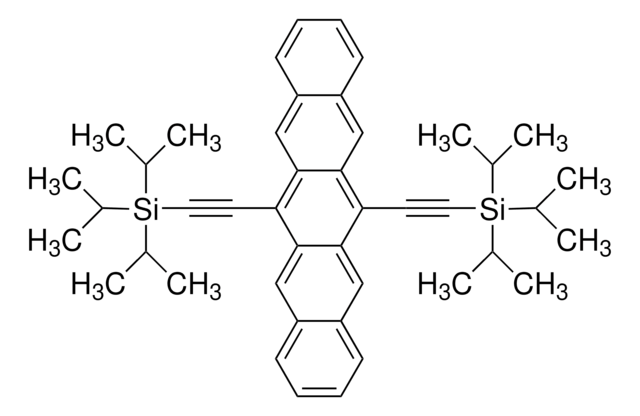663913
N,N′-Dioctyl-3,4,9,10-perylenedicarboximide
98%
Synonyme(s) :
PTCDI-C8
About This Item
Produits recommandés
Niveau de qualité
Pureté
98%
Forme
solid
Pf
>300 °C
λmax
526 nm
Fluorescence
λem ≤533 nm in chloroform
Propriétés du semi-conducteur
N-type (mobility=1.7 cm2/V·s)
Chaîne SMILES
CCCCCCCCN1C(=O)c2ccc3c4ccc5C(=O)N(CCCCCCCC)C(=O)c6ccc(c7ccc(C1=O)c2c37)c4c56
InChI
1S/C40H42N2O4/c1-3-5-7-9-11-13-23-41-37(43)29-19-15-25-27-17-21-31-36-32(40(46)42(39(31)45)24-14-12-10-8-6-4-2)22-18-28(34(27)36)26-16-20-30(38(41)44)35(29)33(25)26/h15-22H,3-14,23-24H2,1-2H3
Clé InChI
YFGMQDNQVFJKTR-UHFFFAOYSA-N
Application
Mention d'avertissement
Warning
Mentions de danger
Conseils de prudence
Classification des risques
Eye Irrit. 2 - Skin Irrit. 2 - STOT SE 3
Organes cibles
Respiratory system
Code de la classe de stockage
11 - Combustible Solids
Classe de danger pour l'eau (WGK)
WGK 3
Point d'éclair (°F)
Not applicable
Point d'éclair (°C)
Not applicable
Équipement de protection individuelle
dust mask type N95 (US), Eyeshields, Gloves
Faites votre choix parmi les versions les plus récentes :
Déjà en possession de ce produit ?
Retrouvez la documentation relative aux produits que vous avez récemment achetés dans la Bibliothèque de documents.
Articles
Aldrich Materials Science highlights recent developments in the applications of organic single-crystal semiconductors which allow their use in organic electronics and energy harvesting.
Self-Assembled Nanodielectrics (SANDs) for Unconventional Electronics
Intrinsically stretchable active layers for organic field-effect transistors (OFET) are discussed. Polymer structural modification & post-polymerization modifications are 2 methods to achieve this.
Notre équipe de scientifiques dispose d'une expérience dans tous les secteurs de la recherche, notamment en sciences de la vie, science des matériaux, synthèse chimique, chromatographie, analyse et dans de nombreux autres domaines..
Contacter notre Service technique


![4,9-Dibromo-2,7-bis(2-octyldodecyl)benzo[lmn][3,8]phenanthroline-1,3,6,8(2H,7H)-tetrone](/deepweb/assets/sigmaaldrich/product/structures/100/693/87f6ccae-153b-4ba6-bd0a-653ba06ece22/640/87f6ccae-153b-4ba6-bd0a-653ba06ece22.png)

![N,N′-Bis[2-(2-tert-butyldimethylsilyloxyethoxy)ethyl]-3,4,9,10-perylenetetracarboxylic diimide 97%](/deepweb/assets/sigmaaldrich/product/structures/334/047/4ac691aa-ae25-4df1-9e0d-09ed12cb8f1f/640/4ac691aa-ae25-4df1-9e0d-09ed12cb8f1f.png)




